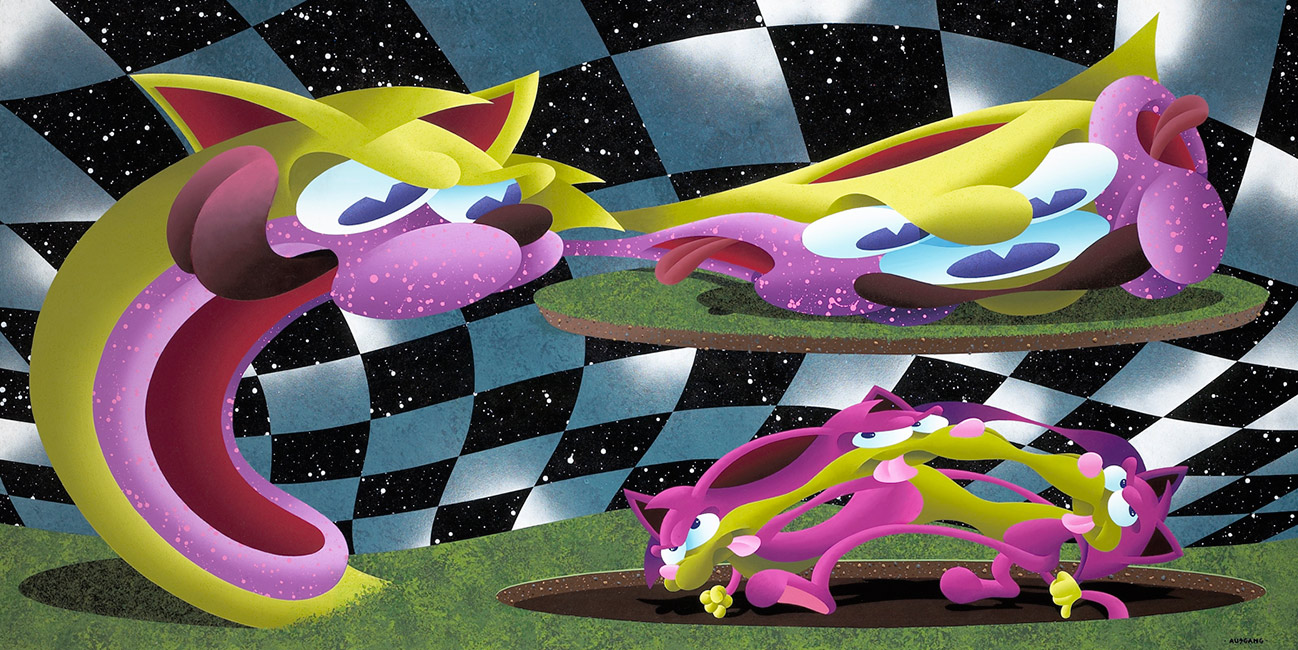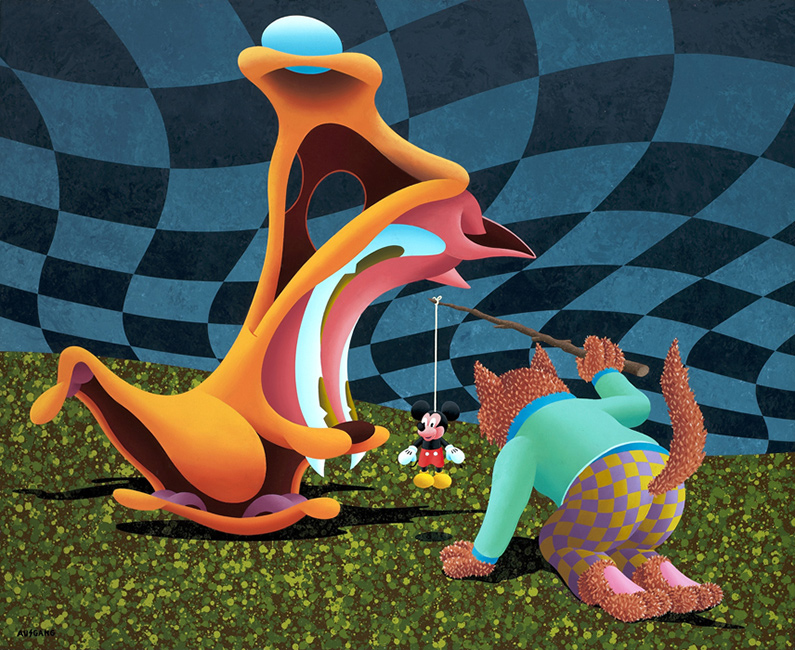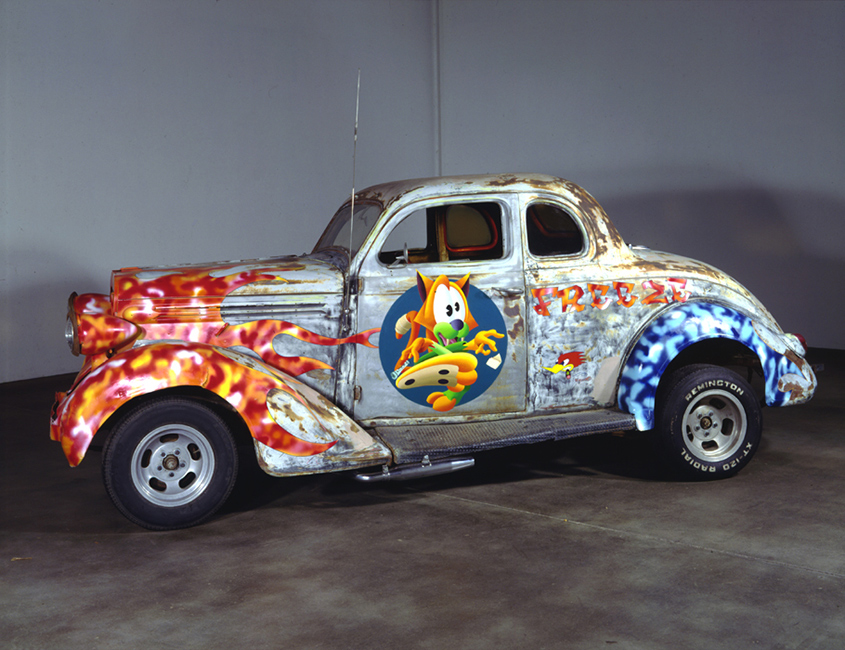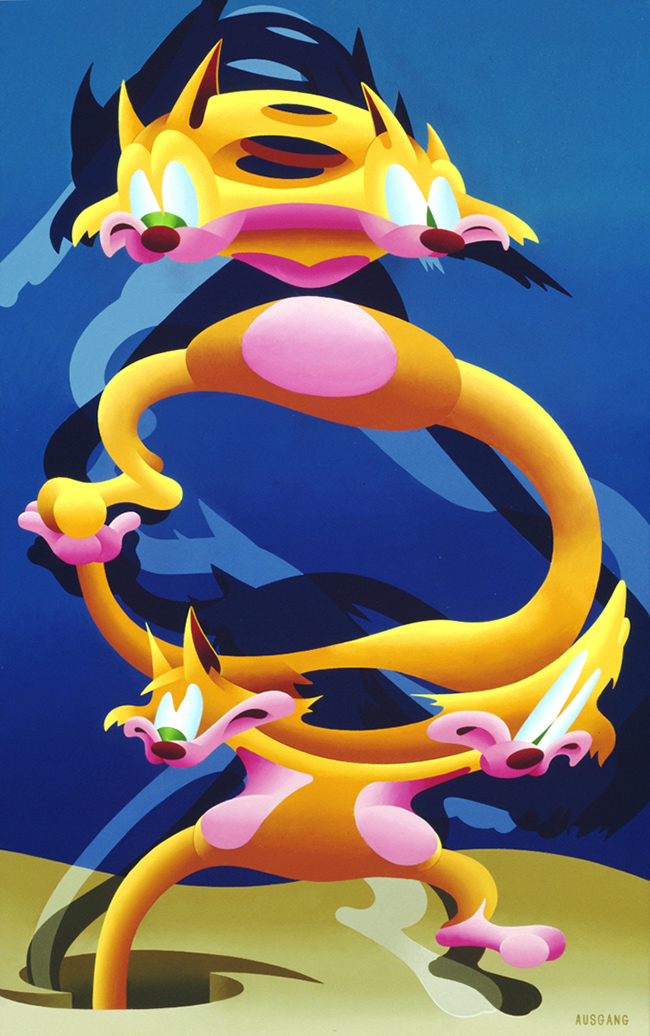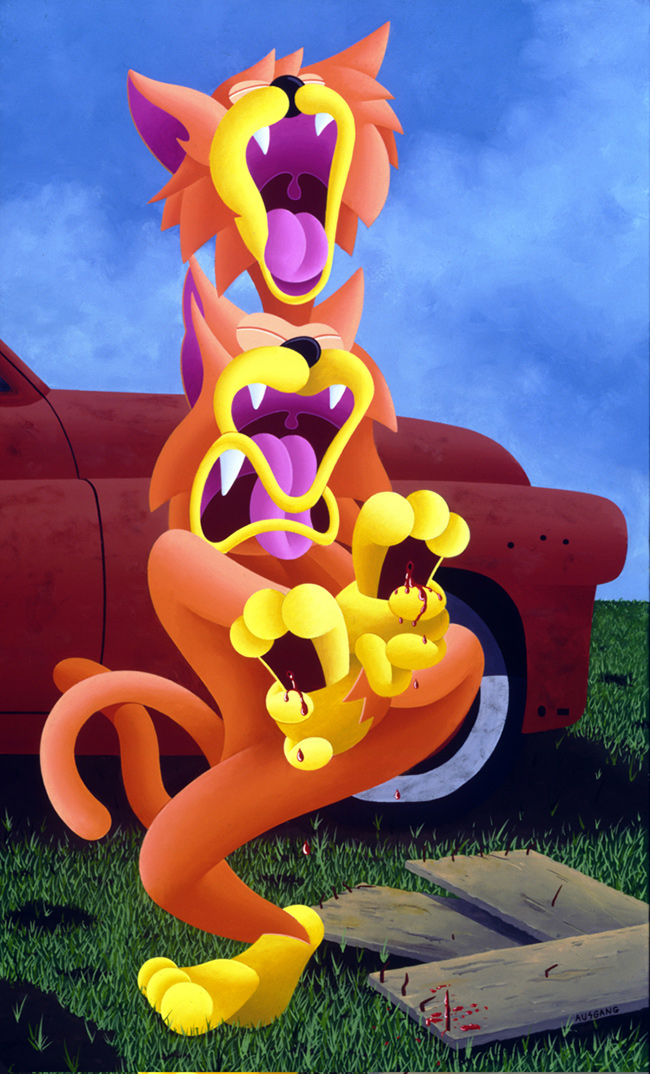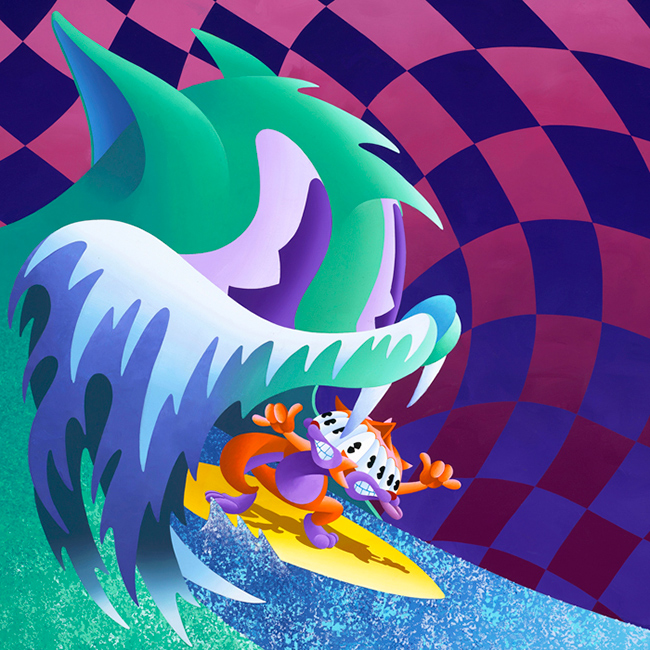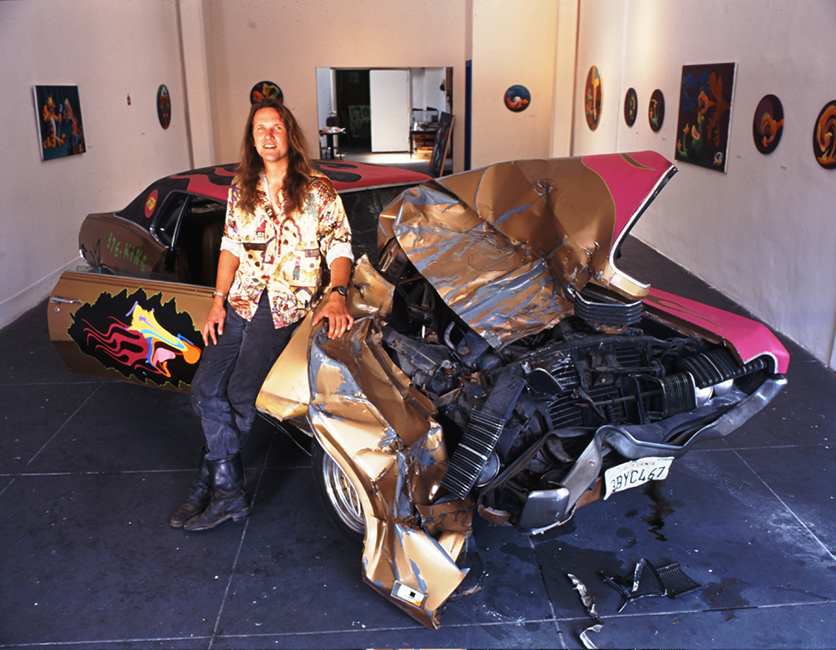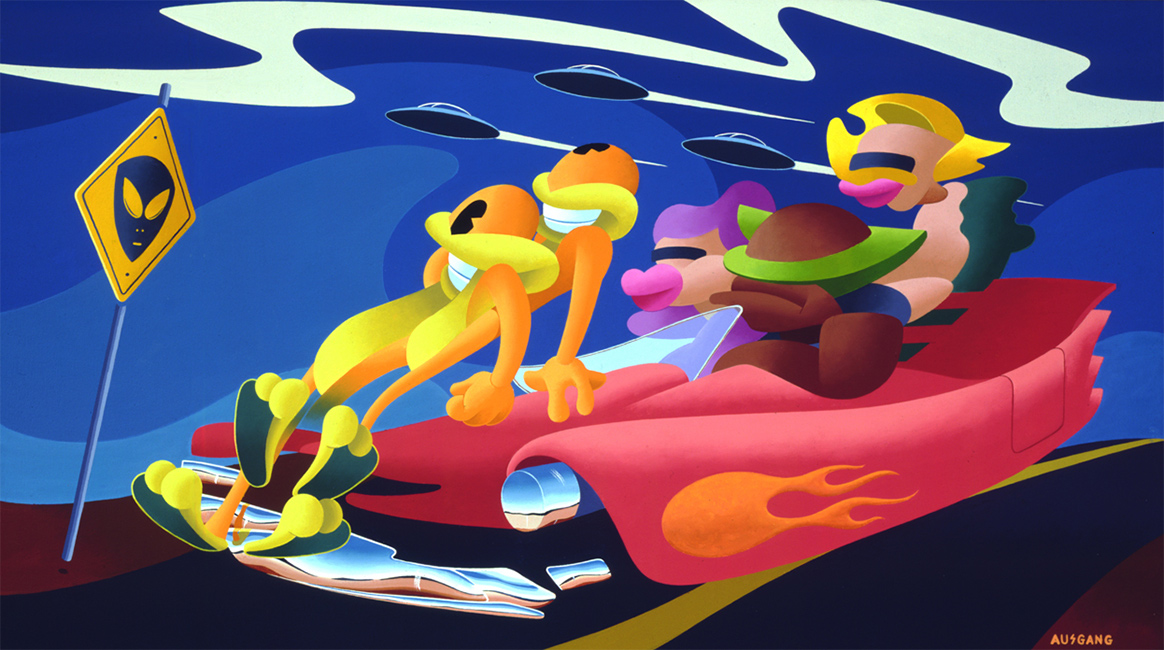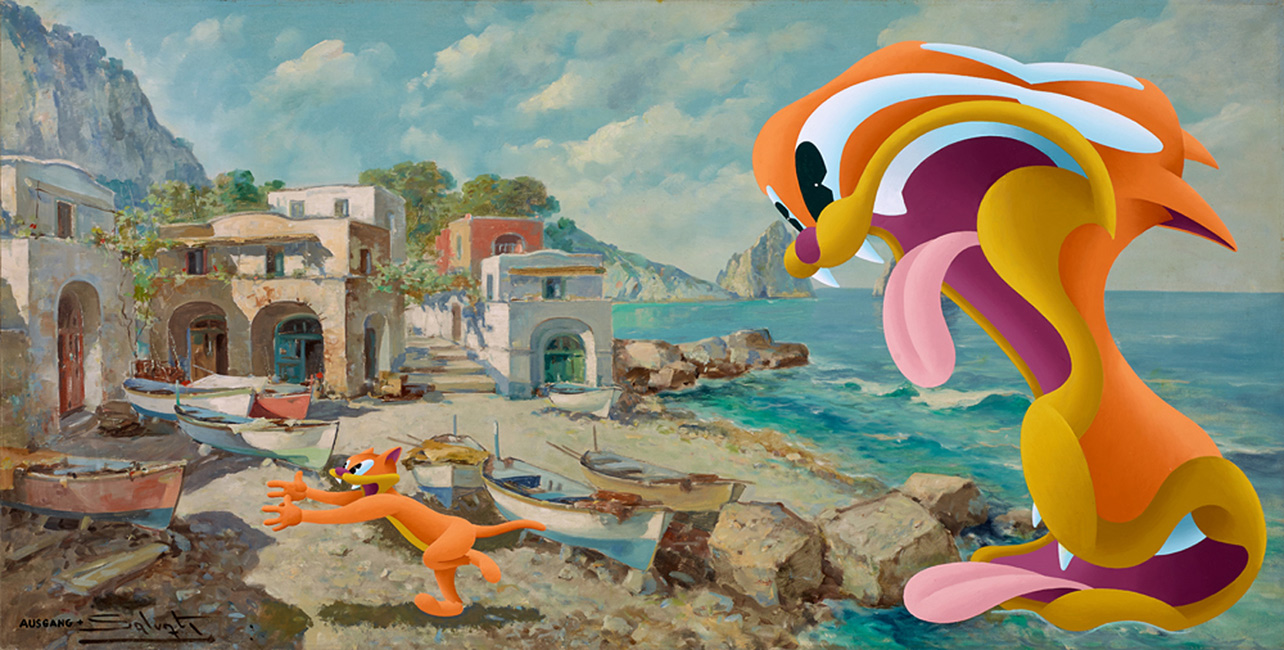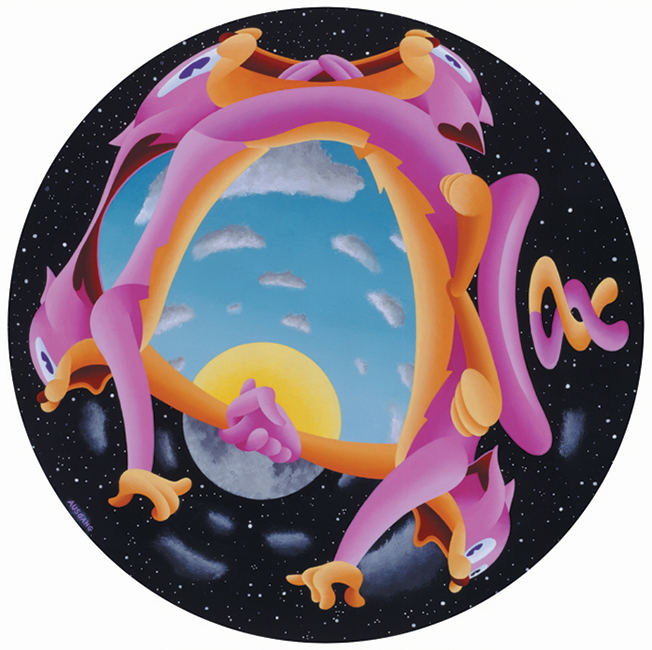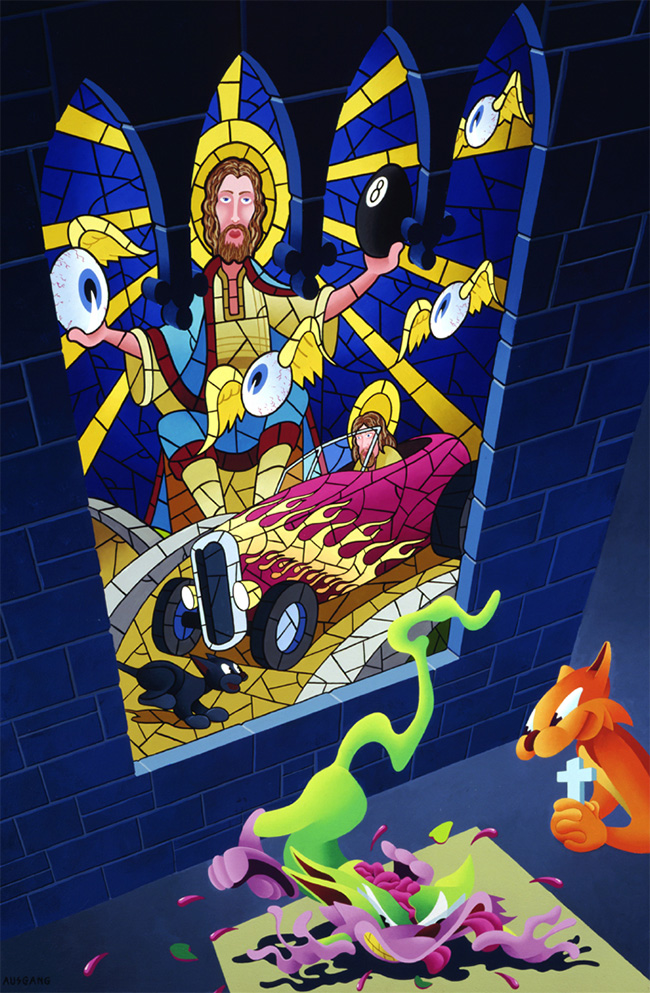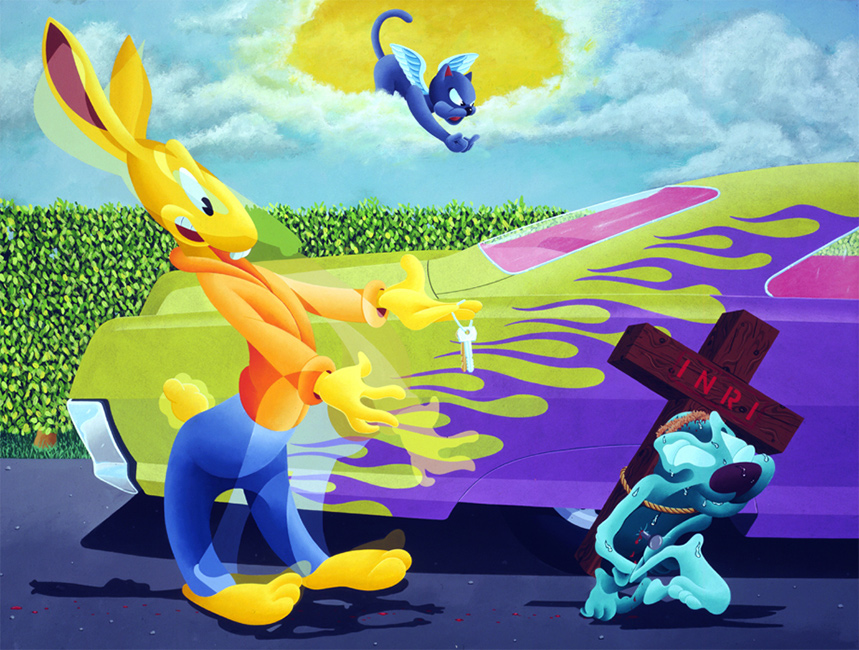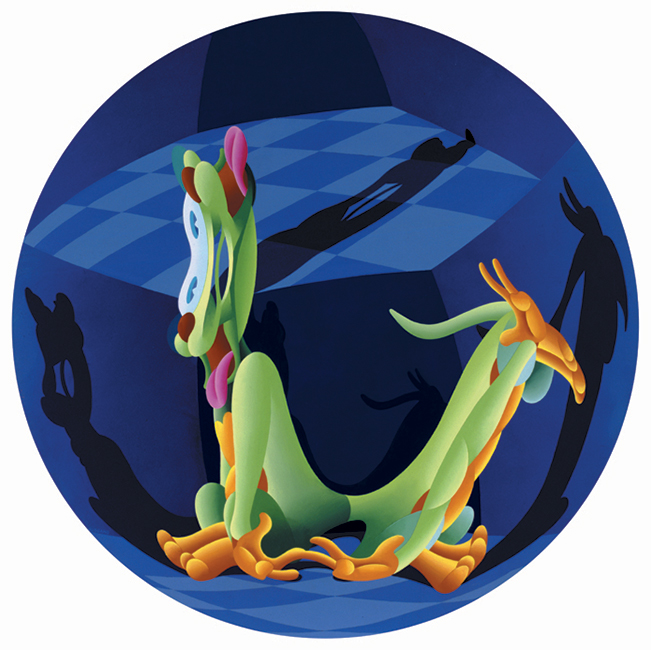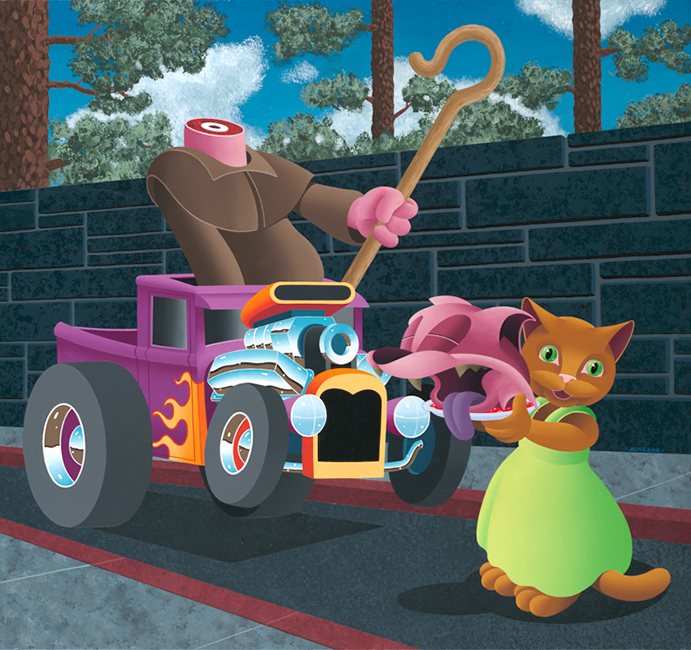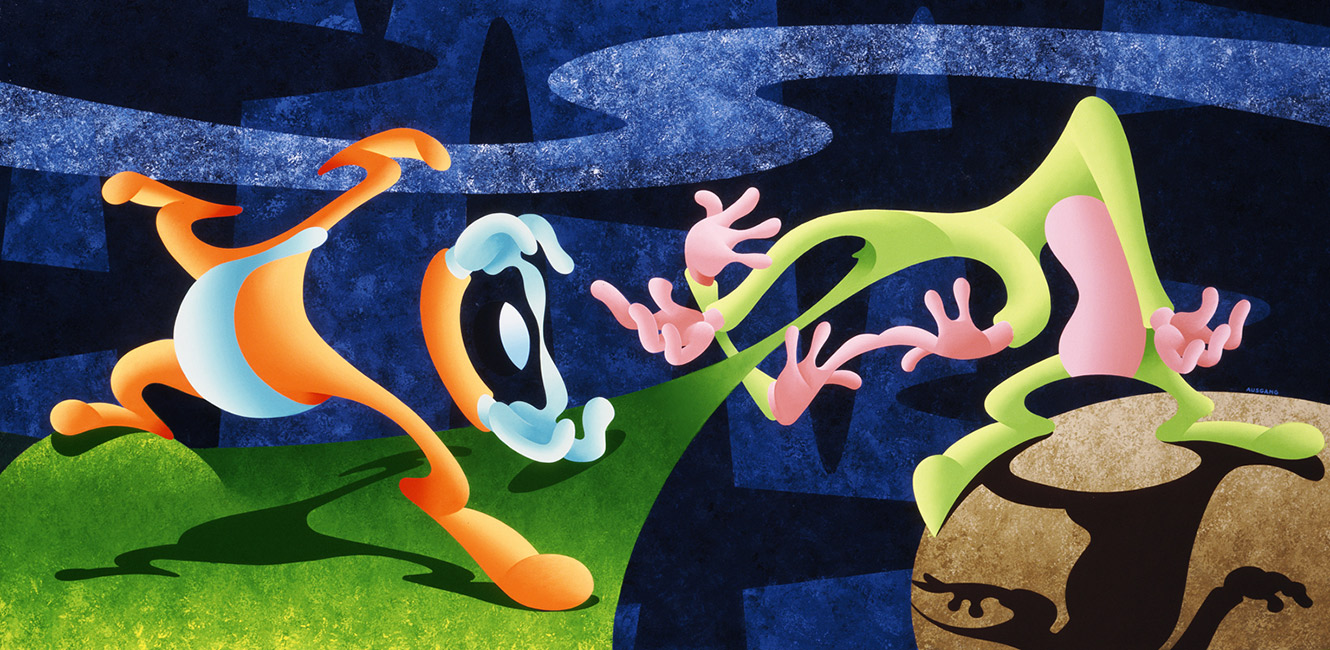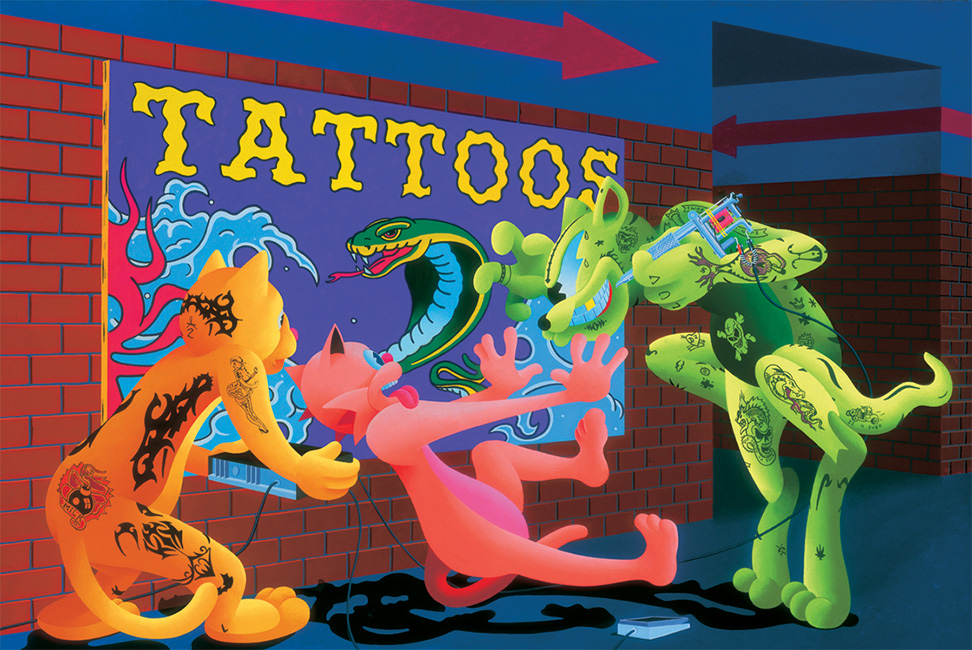Anthony Ausgang is an artist living and working in LA. He is a legend within the world of Lowbrow, a term which may relate to some of his sources of inspiration, but certainly not to his own creative achievements or aspirations. Ausgang’s bold, psychedelic visual statements are filled with cartoon animals who delineate timeless themes pertaining to the human condition. This is the same human condition explored in the world’s greatest and most revered examples of highbrow fine art.
Although Ausgang may be a self proclaimed “art school drop out”, the DIY aesthetic which has been instilled in him since youth (when he lived through the explosion of punk rock), coupled with a relentless drive and motivation to perfect his craft, have proved that the true essence of his art comes from within. It’s about questioning and communicating what it means to be human, and doing so by viewing the world through his own personal lens in the contemporary era.
WOW x WOW are over the moon to have recently had the chance of catching up with Anthony to ask him a few questions about art and life.
Hi Anthony, thanks for taking the time to join us. Before we get started, can you tell us a little about your background and what it was that led to you becoming an artist?
I was born in 1959 in Trinidad and Tobago in the Caribbean but grew up in Houston, Texas, and split for California in 1980. I became an artist because I couldn’t play a musical instrument but I wanted to hang around people who were regarded as either cultural renegades or just plain useless by most people’s standards. Punk rock had a lot to do with it; there was a feeling in the air that a big change was happening and I had to decide which side I was on.
What are your feelings about the academic training you had?
I was quite naïve when I decided to become an artist; I had no idea that there was any such thing as an art school or even a gallery scene for that matter. I thought that artists were just these iconoclastic figures that existed outside of any professional network, practically surviving on air. But once I began taking classes at the Otis Art Institute here in Los Angeles I wised up pretty quickly and began going to every art opening I could find, mostly to “graze” on the free wine and cheese. I learned many technical tricks and got a lot of important art-making information from school but the cost seemed high, and after three semesters I dropped out. I then began working as production painter making hand painted fabric for furniture and learned a lot of painting tricks and wild secret techniques. At the time I figured it was way smarter to get paid while learning at a job than paying to learn in some classroom.
You are celebrated as a pioneer within the second wave of the Lowbrow Art movement, a scene that has always been regarded as an outsider of the art world. What does the term ‘Lowbrow’ mean to you? Also, who or what do you regard as today’s outsider equivalents?
Lowbrow Art is inspired by manifestations of “low culture”, which often involves the revival of obscure marginalia from previous eras. Its nostalgia based, making the lowbrow impulse tinged with an unreality that transits to surreality. It’s unreasonable in that respect; I didn’t begin making art to bring back forgotten icons, it was all about what was going on at the time for me. Some Lowbrow artists traffic in that sort of revivalism but I feel that is suicidal. Will anyone give a shit about the TV show My Favorite Martian in twenty years? Does anyone care now? The point of art is to make timeless messages.
Lowbrow and Outsider Art are cousins; distantly related but mutually exclusive. Lowbrow artists are generally aware of what they are doing and the external value of the finished piece. Outsider artists are working free of such expectations; in a way, that makes them more pure.
Can you talk to us about the psychedelic aspect of your work? One can only assume that the development of your visual aesthetic was expedited through experimentation with some interesting substances – the sort that would be very much at home in Timothy Leary‘s medicine cabinet?
Abstract Art is based on real objects in space and the artist’s interpretation of them; Non-Objective Art is concerned with the expression of an artist’s self-generated images of non-reality. There is a similar differentiation in the psychedelic experience. On LSD, one witnesses the abstraction of a surrounding reality, on DMT one is suddenly involved in a completely distinct non-reality. My “experimentation” with these substances certainly had an influence on my artistic process and I became interested in the point at which a recognizable image becomes unrecognizable; I wanted to pare the image down to the minimal number of visual clues.
Some people may be surprised to learn that you use a computer to aid your compositional development. When did you start using technology as a creative tool and can you describe what you like most about working with digital media?
I began using Adobe Photoshop in the late 90’s when many artists considered it a tool of Satan that was going to bring down the art world. It’s difficult now to image such an attitude, but a Luddite panic seems to occur at just about every technological innovation. I have no doubt that Adobe Photoshop is the greatest innovation in the art making process since the invention of oil paint in the 15th century. I was more than happy to use computer graphics programs to scale images up and down, move elements around; easily accomplish all the things that I previously had to do with scissors, glue and a copy machine. But I was ready for it; in the late 70’s collage was a punk rock medium and I used to spend hours at the copy machine in the library, moving the paper around as it was scanned, doing weird shit with flashlights… In a sense, the very first computer graphics programs were copy machines themselves.
Digital media is a tool that makes many things possible; I can now “remix” my drawings as easily as a musician remixes a song. This makes hybrid visual compositions easy; now my vast library of sketches is not just a repository, it’s a trove of available images I can refer to easily.
Tex Avery had a huge influence on you as a young artist; particularly regarding the way you approach the look and stylization of the characters in your paintings. Can you talk to us a little about your love of Tex and do his animations still inspire you to this day?
Tex Avery was an animator and cartoon director for Warner Bros. and his cartoons were originally made for theatrical release in the 1940s. In the 60s, his cartoons were broadcast on Saturday morning television, and as a kid I was really impressed by the high quality of the sight gags and violence. After the Warner Bros. show, live action “cartoons” such as The Banana Splits would come on with their serious psychedelia, and I guess the two approaches kind of melded together in my mind. Consequently, when I got to The University of Texas, my drawings and paintings started from this “psyche-cartoon” base and there were only a few teachers, like Peter Saul, who got it.
Inspiration is liquid; influence is concrete. Tex Avery will always be my influence; but out of necessity, I am inspired by more recent manifestations of contemporary culture.
You once believed that “art could change the world” and have recently come to the conclusion that this might not be the case in contemporary culture. What do you believe art’s purpose to be now, and what is it that keeps you painting?
Until very recently, art was the domain of an educated cultural elite, and as such, it defied being co-opted by the mainstream; it lacked the same “democracy of stupidity” that ended up neutralizing popular music. Look, eventually everything gets absorbed by the Establishment and used for purposes other than its original intention; for example, the song Rock and Roll by Led Zeppelin was used in a Cadillac commercial. More recently, Shepard Fairey brought Art to the public attention by way of Graffiti and now street crews like TATS CRU are hyping Coca Cola. Art can’t change the world any more because people aren’t interested in making that happen; but apparently art can change the car you drive or the soda you drink.
The power of art has always been in its ability to communicate universally in a non-linguistic way; why even sign language changes in different countries, but a drawing of a cat will always be recognizable as a cat. The purpose of art is to make the invisible visible; once the instant has passed for a perfect photograph, the only way to recreate that moment is to draw or paint it.
The unfortunate truth is that not everybody can, or should be, an artist; what keeps me going as an artist is the knowledge that I have an ability many people don’t, and not to waste it…
Which of your own creations do you feel has been the most successful and why?
My most successful creation was the cover art that I painted for the MGMT album Congratulations. I consider it a success, not because its my most widely recognized image, but because I feel that it perfectly captures the spirit of the music on that album… which is fortunate because they were still mixing the tracks as I was doing the artwork! I also feel that it was success because several people have gotten tattoos of that image on them, which proves it’s worth beyond any association with me personally.
What is your relationship with the history of art and do you feel that it is important to have a good understanding of what has come before? Can you talk about some of the artists from the past who have inspired you and then bring it up to date with some of your contemporary favorites?
Knowledge of history indicates an acceptance of one’s mortality and an understanding that humanity’s accomplishments are the results of individual actions. Art history is no different; if you want to be remembered then you better remember those who went before, because one day, you’re gonna be history too! Remembrance is something we do for the dead who were once just as alive as you, the person reading this.
I don’t have favorite artists so much as favorite art pieces. The Hermitage Museum in Russia has some incredible Dutch and Flemish paintings from the 16th century that manage to clearly get across what it must have been like to be alive then. As far as more recent art, my father used to bring home books like Best New Yorker Cartoons 1948 and from them I got a real definite idea of how to pack as much punch as possible in a single panel.
As far as contemporary artists, well, I’m always looking for undiscovered talent; but it can be so disappointing when someone has everything they need to succeed and it just doesn’t happen.
Having watched or read previous interviews with you it is clear that you’re a person with a wealth of fascinating stories to tell. Can you tell us an anecdote from your career that you’ve never told publicly before?
I showed at an art gallery that also represented an artist who took clothing worn by famous people, dunked them in paint and then displayed them in ornate gold frames. One piece was supposedly made from a dress worn by Rita Hayworth in the movie Gilda, and it sold right away. The collector brought it home, took the dress out of the frame and had it cleaned at vast expense so he could put it on and watch the film. Turned out that the scenes in which Rita Hayworth wore the dress never made the final cut so the collector sued my art dealer. In order to pay for his defense, the dealer told a lawyer he could take three Ausgang paintings as payment, and he gave the value of my work at about 100,000 dollars each, a completely insane amount since my work was selling for maybe 2500 dollars tops at the time. Anyway, my dealer lost the case and the lawyer took possession of three of my paintings as payment. Fast forward to about five years later: I’m talking to some friends at an art opening and I feel this insistent tapping on my shoulder so I turn around and there is the lawyer, red in the face and already screaming at me that my work turned out to be worthless and I had better figure out some way to pay him the money he was owed! I told him it wasn’t my problem but he wouldn’t stop bitching at me so I had to run out the back door of the gallery to get away from him.
What did you set out to achieve in your career as an artist and do you feel that you have come close to your goal?
I moved to Hollywood, California to become a star, just like everyone else getting off the bus; the only difference was I wanted to be an ART star! I guess it happened to some degree since I’m answering your questions and not busking chalk drawings on the sidewalk.
What’s next for Anthony Ausgang?
A solo show at the Copro Gallery in Santa Monica in May 2015!

